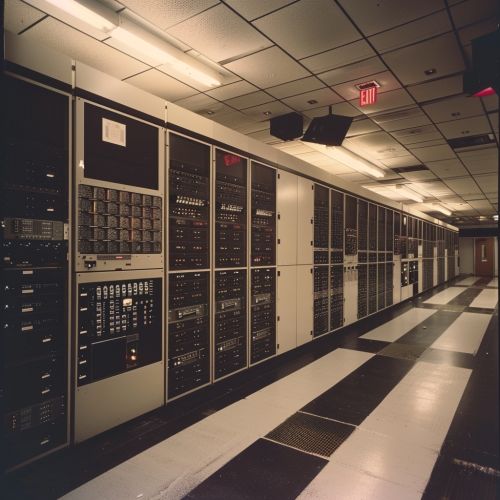IBM mainframe: Difference between revisions
(Created page with "== Introduction == The IBM mainframe is a series of computer systems designed and produced by IBM since the 1960s. The term "mainframe" has been used to describe high-performance computers used for large-scale computing purposes that require greater availability and security than a smaller-scale machine can offer. These systems are primarily used by large organizations for applications requiring high volumes of data processing. <div class='only_on_desktop image-pre...") |
No edit summary |
||
| (One intermediate revision by the same user not shown) | |||
| Line 3: | Line 3: | ||
The [[IBM mainframe]] is a series of computer systems designed and produced by IBM since the 1960s. The term "mainframe" has been used to describe high-performance computers used for large-scale computing purposes that require greater availability and security than a smaller-scale machine can offer. These systems are primarily used by large organizations for applications requiring high volumes of data processing. | The [[IBM mainframe]] is a series of computer systems designed and produced by IBM since the 1960s. The term "mainframe" has been used to describe high-performance computers used for large-scale computing purposes that require greater availability and security than a smaller-scale machine can offer. These systems are primarily used by large organizations for applications requiring high volumes of data processing. | ||
[[Image:Detail-78991.jpg|thumb|center|A large, room-sized computer system with numerous cabinets and consoles.|class=only_on_mobile]] | |||
[[Image:Detail-78992.jpg|thumb|center|A large, room-sized computer system with numerous cabinets and consoles.|class=only_on_desktop]] | |||
== History == | == History == | ||
Latest revision as of 12:04, 16 May 2024
Introduction
The IBM mainframe is a series of computer systems designed and produced by IBM since the 1960s. The term "mainframe" has been used to describe high-performance computers used for large-scale computing purposes that require greater availability and security than a smaller-scale machine can offer. These systems are primarily used by large organizations for applications requiring high volumes of data processing.


History
The history of IBM mainframes dates back to the 1950s, when IBM first introduced the IBM 700/7000 series. This was followed by the System/360 in the 1960s, which was the first family of computers designed to cover the complete range of applications, from small to large, both commercial and scientific.
Architecture
IBM mainframes are known for their complex and robust architecture. The mainframe architecture is based on the principles of high reliability, scalability, and performance. This is achieved through the use of multiple processors, high-speed caches, and a highly efficient I/O system.
Operating Systems
IBM mainframes run on a variety of operating systems, most notably z/OS, z/VM, z/VSE, and Linux on IBM Z. Each of these operating systems is designed to take full advantage of the mainframe's architecture and provide a highly stable and secure environment for running large-scale applications.
Applications
IBM mainframes are used in a wide variety of applications, including banking, insurance, healthcare, government, aviation, and retail industries. These systems are capable of handling large volumes of transactions and provide a high level of security, making them ideal for these types of applications.
Current Models
The current models of IBM mainframes are the IBM z15 and IBM LinuxONE III. These models continue the tradition of high performance, reliability, and security that IBM mainframes are known for.
Future of IBM Mainframes
The future of IBM mainframes looks promising, with IBM continuing to invest in the development of new technologies and features for these systems. This includes advancements in areas such as artificial intelligence, machine learning, and cloud computing.
